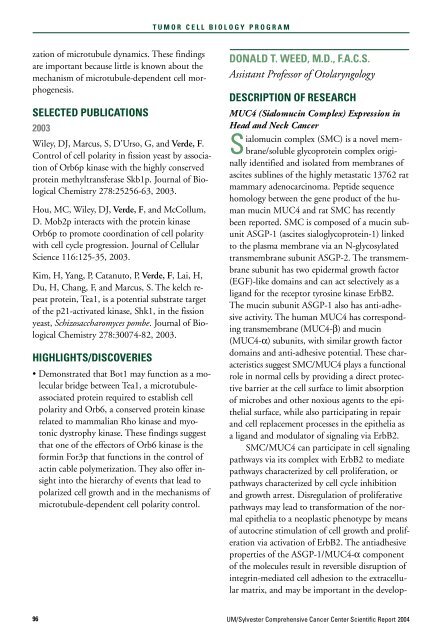SCIENTIFIC REPORT 2004 - Sylvester Comprehensive Cancer Center
SCIENTIFIC REPORT 2004 - Sylvester Comprehensive Cancer Center
SCIENTIFIC REPORT 2004 - Sylvester Comprehensive Cancer Center
You also want an ePaper? Increase the reach of your titles
YUMPU automatically turns print PDFs into web optimized ePapers that Google loves.
T U M O R C E L L B I O L O G Y P R O G R A M<br />
zation of microtubule dynamics. These findings<br />
are important because little is known about the<br />
mechanism of microtubule-dependent cell morphogenesis.<br />
SELECTED PUBLICATIONS<br />
2003<br />
Wiley, DJ, Marcus, S, D’Urso, G, and Verde, F.<br />
Control of cell polarity in fission yeast by association<br />
of Orb6p kinase with the highly conserved<br />
protein methyltransferase Skb1p. Journal of Biological<br />
Chemistry 278:25256-63, 2003.<br />
Hou, MC, Wiley, DJ, Verde, F, and McCollum,<br />
D. Mob2p interacts with the protein kinase<br />
Orb6p to promote coordination of cell polarity<br />
with cell cycle progression. Journal of Cellular<br />
Science 116:125-35, 2003.<br />
Kim, H, Yang, P, Catanuto, P, Verde, F, Lai, H,<br />
Du, H, Chang, F, and Marcus, S. The kelch repeat<br />
protein, Tea1, is a potential substrate target<br />
of the p21-activated kinase, Shk1, in the fission<br />
yeast, Schizosaccharomyces pombe. Journal of Biological<br />
Chemistry 278:30074-82, 2003.<br />
HIGHLIGHTS/DISCOVERIES<br />
• Demonstrated that Bot1 may function as a molecular<br />
bridge between Tea1, a microtubuleassociated<br />
protein required to establish cell<br />
polarity and Orb6, a conserved protein kinase<br />
related to mammalian Rho kinase and myotonic<br />
dystrophy kinase. These findings suggest<br />
that one of the effectors of Orb6 kinase is the<br />
formin For3p that functions in the control of<br />
actin cable polymerization. They also offer insight<br />
into the hierarchy of events that lead to<br />
polarized cell growth and in the mechanisms of<br />
microtubule-dependent cell polarity control.<br />
DONALD T. WEED, M.D., F.A.C.S.<br />
Assistant Professor of Otolaryngology<br />
DESCRIPTION OF RESEARCH<br />
MUC4 (Sialomucin Complex) Expression in<br />
Head and Neck <strong>Cancer</strong><br />
Sialomucin complex (SMC) is a novel membrane/soluble<br />
glycoprotein complex originally<br />
identified and isolated from membranes of<br />
ascites sublines of the highly metastatic 13762 rat<br />
mammary adenocarcinoma. Peptide sequence<br />
homology between the gene product of the human<br />
mucin MUC4 and rat SMC has recently<br />
been reported. SMC is composed of a mucin subunit<br />
ASGP-1 (ascites sialoglycoprotein-1) linked<br />
to the plasma membrane via an N-glycosylated<br />
transmembrane subunit ASGP-2. The transmembrane<br />
subunit has two epidermal growth factor<br />
(EGF)-like domains and can act selectively as a<br />
ligand for the receptor tyrosine kinase ErbB2.<br />
The mucin subunit ASGP-1 also has anti-adhesive<br />
activity. The human MUC4 has corresponding<br />
transmembrane (MUC4-β) and mucin<br />
(MUC4-α) subunits, with similar growth factor<br />
domains and anti-adhesive potential. These characteristics<br />
suggest SMC/MUC4 plays a functional<br />
role in normal cells by providing a direct protective<br />
barrier at the cell surface to limit absorption<br />
of microbes and other noxious agents to the epithelial<br />
surface, while also participating in repair<br />
and cell replacement processes in the epithelia as<br />
a ligand and modulator of signaling via ErbB2.<br />
SMC/MUC4 can participate in cell signaling<br />
pathways via its complex with ErbB2 to mediate<br />
pathways characterized by cell proliferation, or<br />
pathways characterized by cell cycle inhibition<br />
and growth arrest. Disregulation of proliferative<br />
pathways may lead to transformation of the normal<br />
epithelia to a neoplastic phenotype by means<br />
of autocrine stimulation of cell growth and proliferation<br />
via activation of ErbB2. The antiadhesive<br />
properties of the ASGP-1/MUC4-α component<br />
of the molecules result in reversible disruption of<br />
integrin-mediated cell adhesion to the extracellular<br />
matrix, and may be important in the develop-<br />
96<br />
UM/<strong>Sylvester</strong> <strong>Comprehensive</strong> <strong>Cancer</strong> <strong>Center</strong> Scientific Report <strong>2004</strong>
















